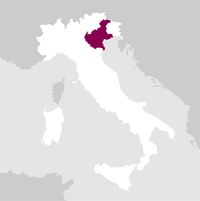Description
Le Bottega Rose Gold est un vin mousseux Brut obtenu à partir de la vinification en rosé des raisins Pinot Noir.
Détails

Perlage

Parfum

Couleur

Goût
Servir à :
06 - 08 °C.
Longévité :
03 - 05 ans

Accords
- Année de création: 1977
- Oenologue: Fabrizio Dorigo
L'engagement de Bottega en matière de développement durable est également primordial : l'entreprise recycle le papier siliconé, utilise au moins 85 % de bouteilles noires en verre recyclé, choisit des peintures à base d'eau pour les bouteilles métallisées, respecte les critères de l'agriculture biologique dans ses vignobles et incorpore des plastiques recyclés dans l'océan. En outre, l'entreprise n'utilise que de l'énergie 100 % renouvelable. Lire la suite


| Nom | Bottega Rosè Gold |
|---|---|
| Type | Rosé vert vin mousseux méthode charmat brut |
| Dénomination | VSQ |
| Format | 0,75 l |
| Teneur en alcool | 11.5% par volume |
| Cépages | 100% Pinot Nero |
| Pays | Italie |
| Région | Lombardie |
| Fournisseur | Bottega |
| Origine | Sur la rive droite du Pô, au sud de la Lombardie, s'étend cette terre de collines vallonnées caractérisée par des conditions climatiques et géomorphologiques extrêmement favorables à la culture de la vigne |
| Climat | Le climat est tempéré, avec de fortes amplitudes thermiques, sec en hiver et venteux en été. |
| Composition du sol | Le sol est sédimentaire avec des marnes composées, en quantités égales, de calcaire et d'argiles fines. |
| Système de culture | Cordon éperonné, Guyot. |
| Plantes par hectare | 4500 |
| Rendement par hectare | 70 - 80 q. |
| Récolte | Fin août - début septembre. |
| Vinification | Les raisins sont récoltés à la main et, après l'égrappage, le moût est laissé en contact avec les peaux pendant 24 heures à 5 °C. La macération à froid permet le développement des substances colorantes et des arômes primaires du raisin présents dans la partie interne de la peau ; la basse température empêche le démarrage de la fermentation et permet également une moindre extraction des tanins et des polyphénols qui donneraient au vin un goût amer et astringent. Le moût rosé est ensuite séparé des peaux par un pressurage doux et fermente à une température contrôlée de 18 °C. |
| Vieillissement | Le vin de base subit une deuxième fermentation selon la méthode Martinotti à une température contrôlée de 14 °C avec l'ajout de levures sélectionnées. Le vin est ensuite laissé sur les lies pour une maturation complète. Enfin, le vin est filtré, mis en bouteille et laissé à reposer dans la bouteille avant d'être mis sur le marché afin que les différents composants retrouvent leur équilibre. |
| Allergènes | Contient des sulfites |




